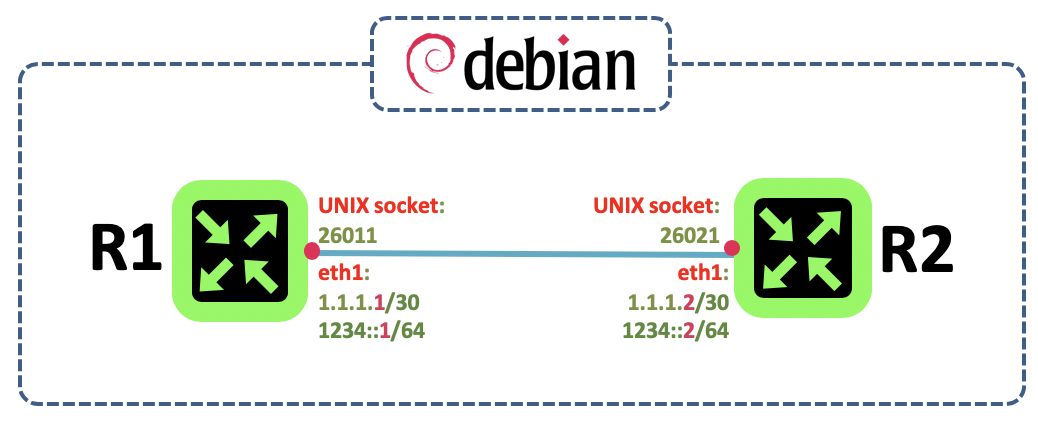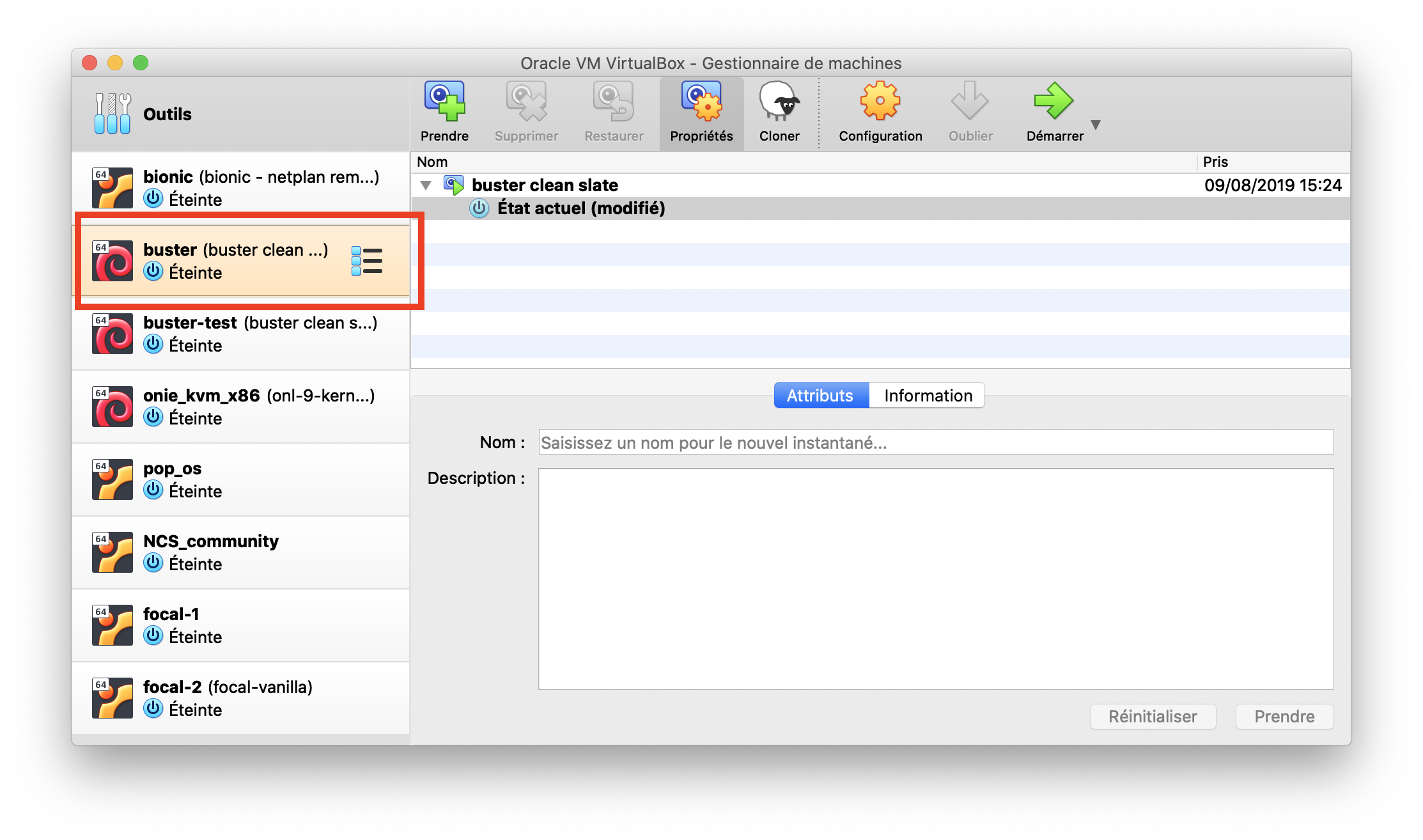The main objective of [RARE / FreeRouter 101] series is to help you getting started with FreeRouter from scratch without any prior knowledge.
Requirement- Basic Linux/Unix knowledge
- Basic networking knowledge
| |
Overview
freeRouter is a free, open source router control plane software. For nostalgic and networkers from prehistoric era (like me), freeRouter besides Ethernet, is able to handle HDLC, X25, frame-relay, ATM encapsulation. Since it handles packets itself at the socket layer, it is independent of underlying Operation System capabilities. We will see in the next articles how freeRouter subtlety leverage this inherently independence to connect different data-plane such as OpenFlow, P4 and other possible data-plane that would appear in the near future.
...
- no global routing table: every routed interface must be in a virtual routing table
- positive side effect: there are no vrf-awareness questions
Article objective
This article is meant to simply deploy 2 instances of freeRouter on the same fresh linux installed linux box. We are voluntary using freeRouter (freerouter.nop.hu) "raw" official repository in order to get familiar with the deployment manual process. Even if the deployment process is straightforward, it is not self explanatory for people non familiar with java/linux.
...
But let's get our "hand dirty" and follow the simple manual installation.
Diagram

[ #001 ] - Cookbook
| Expand |
|---|
| title | Install your favorite operating system |
|---|
|
In our example we will use a genuine debian stable image (buster) installed as a VirtualBox VM. 
|
...
| Expand |
|---|
| title | Launch freeRouters R1 & R2 |
|---|
|
| Code Block |
|---|
| language | bash |
|---|
| theme | Midnight |
|---|
| title | freeRrouter launch with blank parameters |
|---|
| ╭─[12:58:45]floui@debian ~/freeRouter
╰─➤ java -jar ./lib/rtr.jar
java -jar ./lib/rtr.jar <parameters>
parameters:
router <cfg> - start router background
routerc <cfg> - start router with console
routerw <cfg> - start router with window
routercw <cfg> - start router with console and window
routers <hwcfg> <swcfg> - start router from separate configs
routera <swcfg> - start router with sw config
test <cmd> - execute test command
show <cmd> - execute show command
exec <cmd> - execute exec command |
| Code Block |
|---|
| language | bash |
|---|
| theme | Midnight |
|---|
| title | R1 launch with supplied r1-hw.txt and r1-sw.txt with a console prompt |
|---|
| ╭─[12:59:11]floui@debian ~/freeRouter
╰─➤ java -jar lib/rtr.jar routersc etc/r1-hw.txt etc/r1-sw.txt
info cfg.cfgInit.doInit:cfgInit.java:556 booting
info cfg.cfgInit.doInit:cfgInit.java:680 initializing hardware
info cfg.cfgInit.doInit:cfgInit.java:687 applying defaults
info cfg.cfgInit.doInit:cfgInit.java:695 applying configuration
info cfg.cfgInit.doInit:cfgInit.java:721 done
welcome
line ready
r1# |
| Code Block |
|---|
| language | bash |
|---|
| theme | Midnight |
|---|
| title | R2 launch with supplied r2-hw.txt and r2-sw.txt with a console prompt |
|---|
| ╭─[12:58:52]floui@debian ~/freeRouter
╰─➤ java -jar lib/rtr.jar routersc etc/r2-hw.txt etc/r2-sw.txt
info cfg.cfgInit.doInit:cfgInit.java:556 booting
info cfg.cfgInit.doInit:cfgInit.java:680 initializing hardware
info cfg.cfgInit.doInit:cfgInit.java:687 applying defaults
info cfg.cfgInit.doInit:cfgInit.java:695 applying configuration
info cfg.cfgInit.doInit:cfgInit.java:721 done
welcome
line ready
r2# |
|
Verification
| Expand |
|---|
| title | Check telnet access for R1@1123 and R2@2223 |
|---|
|
| Code Block |
|---|
| language | bash |
|---|
| theme | Midnight |
|---|
| title | R1 telnet access from Virtualbox VM guest via port 1123 |
|---|
| ╭─[1:09:28]floui@debian ~
╰─➤ telnet localhost 1123
Trying ::1...
Trying 127.0.0.1...
Connected to localhost.
Escape character is '^]'.
welcome
line ready
r1# |
| Code Block |
|---|
| language | bash |
|---|
| theme | Midnight |
|---|
| title | R2 telnet access from Virtualbox VM guest via port 2223 |
|---|
| ╭─[1:15:37]floui@debian ~
╰─➤ telnet localhost 2223 1 ↵
Trying ::1...
Trying 127.0.0.1...
Connected to localhost.
Escape character is '^]'.
welcome
line ready
r2# |
|
...
| Expand |
|---|
| title | Connectivity test between R1 and R2 |
|---|
|
| Code Block |
|---|
| language | bash |
|---|
| theme | Midnight |
|---|
| title | Ping from R1 -> R2 |
|---|
| r1#ping 1.1.1.2 /vrf v1
pinging 1.1.1.2, src=null, cnt=5, len=64, tim=1000, ttl=255, tos=0, sweep=false
!!!!!
result=100%, recv/sent/lost=5/5/0, rtt min/avg/max/total=1/2/3/13
r1#
r1#ping 1234::2 /vrf v1
pinging 1234::2, src=null, cnt=5, len=64, tim=1000, ttl=255, tos=0, sweep=false
!!!!!
result=100%, recv/sent/lost=5/5/0, rtt min/avg/max/total=1/4/11/23
r1# |
| Code Block |
|---|
| language | bash |
|---|
| theme | Midnight |
|---|
| title | Ping from R2 -> R1 |
|---|
| r2#ping 1.1.1.1 /vrf v1
pinging 1.1.1.1, src=null, cnt=5, len=64, tim=1000, ttl=255, tos=0, sweep=false
!!!!!
result=100%, recv/sent/lost=5/5/0, rtt min/avg/max/total=0/1/2/12
r2#
r2#ping 1234::1 /vrf v1
pinging 1234::1, src=null, cnt=5, len=64, tim=1000, ttl=255, tos=0, sweep=false
!!!!!
result=100%, recv/sent/lost=5/5/0, rtt min/avg/max/total=0/1/3/7
r2# |
| Code Block |
|---|
| language | bash |
|---|
| theme | Midnight |
|---|
| title | Initiate IPv4 telnet from R1 -> R2 (inside freeRouter scope) |
|---|
| r1#telnet 1.1.1.2 23 /vrf v1
- connecting to 1.1.1.2 23
welcome
line ready
r2# |
| Code Block |
|---|
| language | bash |
|---|
| theme | Midnight |
|---|
| title | Initiate IPv6 telnet from R2 -> R1 (inside freeRouter scope) |
|---|
| r2#telnet 1234::1 /vrf v1
- connecting to 1234::1 23
welcome
line ready
r1# |
|
Conclusion
In this article you:
- had a brief introduction of freeRouter networking Swiss army knife
- learn how to deploy 2 instances of freeRouter and interconnect them via 2 UNIX sockets on a VM guest running on VirtualBox
- this setup is ideal, for network simulation encompassing hundreds of nodes, self contained in the same VM without interaction with the external world. (protocol experimentation, convergence test etc.)
...


